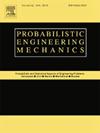球形(S2)流形上随机激发系统的实时异常检测
IF 3.5
3区 工程技术
Q2 ENGINEERING, MECHANICAL
引用次数: 0
摘要
在当今不断变化的复杂系统中,先进的分析工具已变得至关重要。实时主大地分析法(RPGA)是一种新颖的技术,为分析可变流形上的非线性数据提供了独特的视角。传统的线性方法往往不足以探索此类数据的复杂性。主成分分析(PCA)和主大地分析(PGA)等正交变换技术非常适用于机械、航空航天和土木工程等领域的随机激励系统的状态监测。然而,由于不确定性和动态波动,有必要采用稳健的分析方法进行早期变化检测,以确保安全、性能和成本效益。由于线性正交变换技术(如 PCA 及其递归对应技术)的局限性,必须将这些技术应用于非线性情况,即数据并非在平坦的欧几里得空间中演化。近几十年来,这一领域取得了重大进展,RPCA、RCCA 和 RSSA 等数据驱动型实时算法为复杂的多维问题提供了可靠的解决方案。然而,对于曲线空间,非线性 RPGA 技术占据了中心位置。众所周知,它能有效地从复杂数据流中提取有意义的信息。本文探讨了从线性数据分析过渡到非线性数据分析的基本概念和方法。通过研究 S2 上的随机几何振荡器和在粗糙表面上航行的倒球摆小车系统等示例,我们说明了 RPGA 等工具提供的可靠、实时损坏检测技术的重要性。本文章由计算机程序翻译,如有差异,请以英文原文为准。
Real-time anomaly detection of the stochastically excited systems on spherical (S2) manifold
Advanced analytical tools have become crucial in today’s constantly changing and complex systems. Real-time Principal Geodesic Analysis (RPGA) is a novel technique that provides a unique perspective for analyzing nonlinear data on differentiable manifolds. Traditional linear methods are often inadequate when exploring the complexities of such data. Orthogonal transformation techniques such as Principal Component Analysis (PCA) and Principal Geodesic Analysis (PGA) are highly desirable for condition monitoring stochastically excited systems in domains like mechanical, aerospace, and civil engineering. However, uncertainties and dynamic fluctuations necessitate robust analytical methods for early change detection to ensure safety, performance, and cost-effectiveness. Limitations posed by linear orthogonal transformation techniques such as PCA and its recursive counterparts make it imperative to adapt these techniques to nonlinear situations where data does not evolve in a flat Euclidean space. Significant advancements have been made in this field over recent decades, with data-driven real-time algorithms such as RPCA, RCCA, and RSSA providing reliable solutions for complex multidimensional problems. However, for curved space, the nonlinear RPGA technique takes center stage. It is known for its effectiveness in extracting meaningful information from the complex data stream. This paper explores the foundational concepts and methodologies underlying the transition from linear to nonlinear data analysis. By examining examples such as stochastic geometric oscillator on , and the inverted spherical pendulum cart system navigating a rough surface, we illustrate the significance of reliable, real-time damage detection techniques provided by tools such as RPGA.
求助全文
通过发布文献求助,成功后即可免费获取论文全文。
去求助
来源期刊

Probabilistic Engineering Mechanics
工程技术-工程:机械
CiteScore
3.80
自引率
15.40%
发文量
98
审稿时长
13.5 months
期刊介绍:
This journal provides a forum for scholarly work dealing primarily with probabilistic and statistical approaches to contemporary solid/structural and fluid mechanics problems encountered in diverse technical disciplines such as aerospace, civil, marine, mechanical, and nuclear engineering. The journal aims to maintain a healthy balance between general solution techniques and problem-specific results, encouraging a fruitful exchange of ideas among disparate engineering specialities.
 求助内容:
求助内容: 应助结果提醒方式:
应助结果提醒方式:


